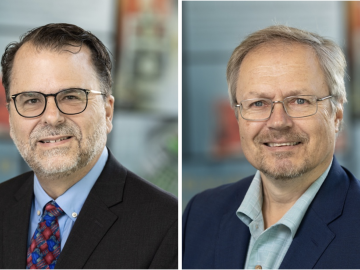
Filter News
Area of Research
- (-) Clean Energy (104)
- (-) Supercomputing (43)
- Advanced Manufacturing (1)
- Biology and Environment (94)
- Biology and Soft Matter (1)
- Building Technologies (3)
- Climate and Environmental Systems (5)
- Computational Engineering (2)
- Computer Science (6)
- Electricity and Smart Grid (1)
- Functional Materials for Energy (1)
- Fusion and Fission (9)
- Fusion Energy (7)
- Isotopes (1)
- Materials (40)
- Materials for Computing (6)
- Mathematics (1)
- National Security (12)
- Neutron Science (11)
- Nuclear Science and Technology (11)
- Nuclear Systems Modeling, Simulation and Validation (1)
News Topics
- (-) Advanced Reactors (7)
- (-) Big Data (25)
- (-) Buildings (39)
- (-) Environment (68)
- (-) Polymers (13)
- 3-D Printing/Advanced Manufacturing (80)
- Artificial Intelligence (41)
- Bioenergy (29)
- Biology (19)
- Biomedical (22)
- Biotechnology (6)
- Chemical Sciences (16)
- Clean Water (8)
- Climate Change (35)
- Composites (17)
- Computer Science (107)
- Coronavirus (25)
- Critical Materials (12)
- Cybersecurity (14)
- Decarbonization (35)
- Energy Storage (75)
- Exascale Computing (25)
- Fossil Energy (2)
- Frontier (29)
- Fusion (2)
- Grid (42)
- High-Performance Computing (41)
- Hydropower (2)
- Isotopes (2)
- Machine Learning (19)
- Materials (45)
- Materials Science (40)
- Mathematics (3)
- Mercury (3)
- Microelectronics (1)
- Microscopy (14)
- Molten Salt (1)
- Nanotechnology (15)
- National Security (11)
- Net Zero (4)
- Neutron Science (20)
- Nuclear Energy (11)
- Partnerships (12)
- Physics (8)
- Quantum Computing (19)
- Quantum Science (25)
- Renewable Energy (1)
- Security (9)
- Simulation (17)
- Software (1)
- Space Exploration (6)
- Statistics (1)
- Summit (44)
- Sustainable Energy (71)
- Transformational Challenge Reactor (3)
- Transportation (70)
Media Contacts

The Summit supercomputer, once the world’s most powerful, is set to be decommissioned by the end of 2024 to make way for the next-generation supercomputer. Over the summer, crews began dismantling Summit’s Alpine storage system, shredding over 40,000 hard drives with the help of ShredPro Secure, a local East Tennessee business. This partnership not only reduced costs and sped up the process but also established a more efficient and secure method for decommissioning large-scale computing systems in the future.

Stephen Kowalski and Mikael Salonvaara received the Distinguished Service Award, which salutes members who have served the society with distinction in chapter, regional and society activities.

Kashif Nawaz, distinguished researcher and section head for Building Technologies Research at the Department of Energy’s Oak Ridge National Laboratory, has been named a Fellow of the American Society of Mechanical Engineers, or ASME.

A team of computational scientists at ORNL has generated and released datasets of unprecedented scale that provide the ultraviolet visible spectral properties of over 10 million organic molecules.

Karen White, who works in ORNL’s Neutron Science Directorate, has been honored with a Lifetime Achievement Award.

Scientists at ORNL used their knowledge of complex ecosystem processes, energy systems, human dynamics, computational science and Earth-scale modeling to inform the nation’s latest National Climate Assessment, which draws attention to vulnerabilities and resilience opportunities in every region of the country.

ORNL researchers demonstrated that an additive made from polymers and electrolytes improves the thermal performance and stability of salt hydrate phase change materials, or PCMs, a finding that could advance their integration into carbon-reducing heat pumps.

The world’s first exascale supercomputer will help scientists peer into the future of global climate change and open a window into weather patterns that could affect the world a generation from now.

In fiscal year 2023 — Oct. 1–Sept. 30, 2023 — Oak Ridge National Laboratory was awarded more than $8 million in technology maturation funding through the Department of Energy’s Technology Commercialization Fund, or TCF.

ORNL has been selected to lead an Energy Earthshot Research Center, or EERC, focused on developing chemical processes that use sustainable methods instead of burning fossil fuels to radically reduce industrial greenhouse gas emissions to stem climate change and limit the crisis of a rapidly warming planet.


